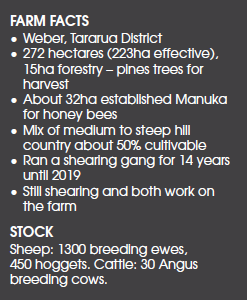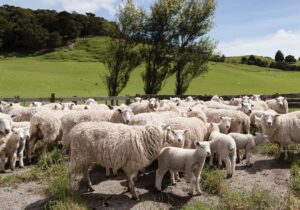Shearing sparks life
Shearing has been a way of life for Weber farmers Justin and Diane Bell. It’s been a way to see the world and achieve their goal of farm ownership. Story by Rebecca Greaves. Photos by Brad Hanson.

Shearing has been a way of life for Weber farmers Justin and Diane Bell. It’s been a way to see the world and achieve their goal of farm ownership. Story by Rebecca Greaves. Photos by Brad Hanson.
A diverse sheep and beef farming operation, coupled with off-farm income has provided the Bells with the life they dreamed of.
The farm at Weber, in the Tararua district, is a breeding operation and they aim to finish all lambs. They also have a small elite Texel flock, selling 15-20 rams annually.
Justin (48) describes the stud side as a bit of a hobby.
While raising a young family the couple also ran their shearing contracting business alongside the farm. Justin was off farm shearing and Diane undertaking most of the farm work. Diane also spent 12 years working at the local pub.
The shearing business was sold two and-a-half years ago, but despite his best intentions, Justin can’t seem to stay away. He recently took on a role as lead shearer trainer for newly formed WOMOlife, which is tasked with delivering training for the industry.

They bought Waipatiki 17 years ago and, five years later, the neighbouring farm came up for lease, which they took on. After several years they bought the lease farm too. Until recently, they had leased Diane’s family farm in Feilding, which was predominantly flat and used for finishing.
Justin grew up in Taihape, while Diane is from Kimbolton. Shearing and farming is in the blood for both.
“Our goal was to own our own farm but still be able to work off-farm.”
Justin says he couldn’t have been on a hand piece if it weren’t for Diane.
“All the dogs work for her, she drenches and dags.”
There are 1300 breeding ewes and the aim is to finish all lambs. Recently, they have introduced a Coopworth cross in a bid to lift the lambing percentage.
“We’re looking for a meaty breed and, with the Coopworth, more wool but to still have the bulk of the Texel. And hopefully more lambs.”
They have 450 hoggets, which are lambed. Anything over 42kg goes to the ram.
The lambing is usually 130-140% and Justin hopes they can lift this to 150-160% with the Coopworth cross. Scanning is 160-170% including two-tooth ewes.
He says the good thing about the Texel is they yield and can be killed at lower weights.
It was a big decision to go to Coopworth.
“We’re looking for the best of both worlds.”
They lamb in early September and start weaning in the second week of December.
The Texel lambs yield about 51% in lambs off mum. A 38kg liveweight lamb will generally kill out at an average 19kg carcaseweight. Once weaning starts they keep chipping away and the aim is to have everything gone by the end of March.
Cropping plays an important part in getting lambs up to weight and they have 10-12 hectares in Pacer leafy turnips. The Bells regrassing programme is into turnips and then back into new grass.
Summers seem to be getting drier so they are looking at different options. This year they are trying raphanobrassica because of its long tap root and ability to hang on in the dry. It is a hybrid between kale and radish.
Apart from lamb finishing, the crops have been used to lift tail end ewes. Anything that’s light goes on there after weaning.
“That’s our number one priority and I reckon that’s our best investment.”
In terms of the cost of the cropping versus the gains in productivity Justin admits he’s not much of a facts and figures man.
“When I was in the shearing gang, the last thing I felt like doing was sitting down and working out figures at night.”
The cattle policy is simple and works well. A herd of 30 Angus breeding cows, bought from Kiwi Station in Wairoa. They use an Angus bull and calving is at the end of September. They calve at about 90% and all progeny are sold at the weaner fairs in March.
Justin says they don’t have enough room to winter R1 cattle. The main objective for the cows is clean-up, and they make a good job of it.
The Bells keep a tight rein on expenses, they do their own shearing, and animal health is minimal.
Justin tries to minimise the use of drench, though ewes are drenched for barber’s pole pre-tup and lambs are drenched.
Ewes are vaccinated for Toxo and Campy and receive a five-in-one. Cattle only get a salt lick and a dip annually.
Their faecal egg counts have always been low.
They have poured most of their profits back into farm development, with a focus on establishing good pasture through drainage and regrassing. All development is funded through cashflow.
No honey no money
Alongside the stock, the Bells have created an income stream from honey on the established Manuka blocks through a partnership with Hinterland Foods.
They have also replanted an area that previously had pine trees with Manuka.
Justin says the previous owner retained the cutting rights on that bit of land. They harvested the trees and the whole hill was slipping into the river. They decided to plant about 10,000 Manuka stems.
They already had about 32ha of established Manuka.
“I don’t mind forestry, but pines aren’t what I want to look at.”
There is also 15ha of harvestable pine trees, which they hope will be logged this summer.
Diversity has been the couple’s key to success.
“It’s about spreading the risk and not having all the eggs in one basket or on one market.
They will keep chipping away with the Texel rams and shearing is well paid.
Setting records
Justin doesn’t do a lot of shearing because he is busy training shearers around the country. He is happy to spend less time on the handpiece.
“I don’t want to be out there smashing it every day, I’ve been there, done that.”
And he certainly has done almost all there is to do at the highest level of the shearing industry, winning the senior title at the Golden Shears and setting two world records (one of which still stands).
It all started when he was 19. He was stacking boxes at Watties and decided there had to be more to life. His father was a shearer and it seemed logical to pick up a handpiece.
“Pretty much the day I walked in the shed I knew, that was me.”
He started as a presser and progressed to shearing. For Justin, the industry represents the whole package. “I like the fitness, endurance, the people, the friendships and camaraderie, the banter.”
It’s taken Diane and Justin all around the world, she was wool handling and he was shearing.
The couple worked down south, in Australia and the United Kingdom.
“Hopefully someone reading this will decide to go shearing so I can retire.”
His credentials speak for themselves. Justin competed on the show circuit and won the Senior Golden Shears title, before the pull of endurance and chasing records became his number one focus.

He set his first world record in 2002 which still stands. It was a two-stand eight-hour strong wool lamb record and the pair shore 1406 lambs. Justin’s tally was 731 lambs, breaking the individual eight-hour record on the same day.
In 2004 he set a solo world record, shearing 851 lambs in a nine-hour strong wool record.
He likes setting goals and achieving them.
“That tally thing, you do your first 100, then 200, then 300 and you think ‘I could do another hundred’.
“It keeps growing and becomes even more of a driver.
He gets an adrenaline buzz when attempting records and has to manage it.
“You have to wind down or you just fatigue out.”
He has done a lot of work on mental control, “…when you’re close to a record, you have to have that control.”
In 2005 when the Bells moved to Weber, they decided running a shearing contracting business would be a good complimentary income. They ran it for 14 years and it was time to enjoy a slower pace of life.
Their three children Daniel, 20, Hayden, 18, and Amy, 16, have nearly all left home and are embarking on their own careers.
They were also leasing Diane’s family farm in Feilding for a period. Without the support of Diane’s parents, they couldn’t have done it, Justin says.
He says selling the shearing business was a huge decision but something had to go.
But he loves shearing.
“It’s in the blood and I don’t think I will ever leave the industry.”
There are still improvements to be made, and more goals to meet.
 Training the next generation
Training the next generation
LONG-TIME SHEARER JUSTIN BELL THOUGHT HE would ease off, maybe do some casual shearing locally. Little did he know he was about to be pulled back into the industry – this time in a different capacity.
It was while he was attending a show with daughter Amy, who was competing in the wool handling, that Weber farmer Justin landed his new job as lead shearer trainer for WOMOlife.
WOMOlife stands for Work wise, Move wise, for a longer, more sustainable career in the industry. It is the new government-funded model to deliver training in the agricultural sector and includes courses for wool handling, shearing, wool pressing and shed hands.
His motivation is to help others, and to secure a future of skilled shearers.
He wants to make it easier for them.
“I like the smiles on their faces when you teach them, and they’re rapt.”
The industry has issues with quality and attitude, and that’s a big focus.
Justin would like to see more government funding for training. He says the opportunities are endless, for those who are willing to work hard in the industry.




